- Arribas, S., Mediavilla, E., Fuensalida, J. J., 1998b, ApJL, 505, 43.
- Arribas, S., et al., 1998a, SPIE Proc., 3355, 821.
- Arribas, S., et al., 1991, ApJ, 369, 260.
- Balcells, M. et al., 2000, ApJ, in press.
- Bingham, R. G., Gellatly, D. W., Jenkins, C. R., & Worswick, S. P., 1994, SPIE Proc., 2198, 56.
- Charles, P. A. et al., 2000, in preparation.
- Colina, L., Arribas, S., & Borne, K. D., 1999, ApJ, 527, L13.
- del Burgo, C., Mediavilla, E., & Arribas, S., 2000, ApJ, in press.
- García, A., Rasilla, J. L., Arribas, S., & Mediavilla, E., 1994, SPIE Proc., 2198, 75.
- García-Lorenzo, B., Arribas, S., & Mediavilla, M., 2000, in Proceedings of "Imaging the Universe in Three Dimensions: Astrophysics With Advanced Multi-Wavelength Imaging Devices", in ASP Conf. Series, 195, 325.
- García-Lorenzo, B., Cairós, L. M., Caon, N., & Vílchez, J., 2000, in Proceedings of "The Evolution of Galaxies I. Observational Clues", to be published in ASP Conf. Series.
- Mediavilla et al., 1998, ApJL, 503, 27.
- de Zeeuw, P. T. et al., 2000, ING Newsletter, 2, 11.
| THE ING NEWSLETTER | No. 3, September 2000 |
|
|
SCIENCE |
|
|
|
| Previous: | S-Cam Update - Novel Capabilities for Resolving Old Problems ! | Up: | Table of Contents | Next: | Fibre Feeding the UES |
Other available formats: PDF | gzipped Postscript
INTEGRAL: A Simple and Friendly Integral Field Unit Available at the WHT
Begoña García-Lorenzo1, Santiago Arribas2 and Evencio Mediavilla2
1: Isaac Newton Group of Telescopes (ING); 2: Instituto de Astrofísica de Canarias
Integral-field spectroscopy (IFS) has merited much attention in recent years due to its advantages with respect to classical sequential 2-D spectroscopic techniques (e.g., long-slit scans, Fabry-Perot) when studying relatively small extended objects. IFS is able to simultaneously obtain a spectrum for each spatial sample of a two-dimensional field.
Most of the advantages of the IFS technique are direct consequences of the simultaneity when recording spatial and spectral information. Indeed, there is no need to worry about the differential atmospheric refraction, nor to adapt the slit width (spectral resolution) to the seeing conditions. The configuration of IFS makes unnecessary an accurate centering of the slit. The simultaneity does not only imply a more efficient way to observe but, more importantly, it guarantees a great homogeneity in the data. Several implementations of the IFS technique have been developed, based in the use of fibres, microlenses, micro-mirrors, or mixed solutions.
Early implementations of fibre projects at the Roque de los Muchachos Observatory were led by Peter Gray more than a decade ago. During all this time, the WHT has played an important role in the development of the IFS. Several fibre IFS instruments have been built (HEXAFLEX, Arribas et al., 1991; 2D-FIS, García et al., 1994, and now INTEGRAL, Arribas et al., 1998a). More recently SAURON (de Zeeuw et al., 2000), which is based on the microlenses approach has also been successfully used at the WHT. Future projects include TEIFU and OASIS, which combine the advantages of IFS and AO.
INTEGRAL
INTEGRAL is used in combination with the WYFFOS spectrograph (Bingham et al., 1994), and it is mounted in the Nasmyth 1 platform (GHRIL) of the WHT (see Figure 1).
In the standard configuration three fibre bundles (see Figure 2 for their main characteristics) are simultaneously connected at the entrance pseudoslit of the WYFFOS spectrograph. The bundles can be easily interchanged at the focal plane, with an overhead of a few seconds. Hence, depending on the prevailing seeing conditions and/or spatial requirements, the instrument can be easily optimised for the scientific program. The bundles can also be oriented to the desired sky position angle.
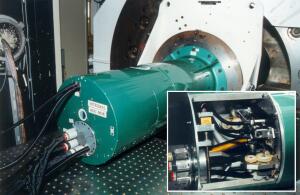 |
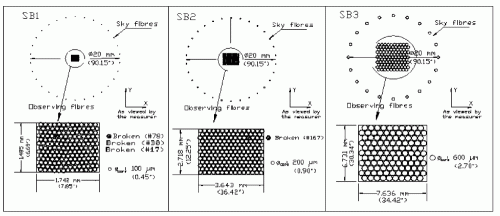 |
| Figure 1. Acquisition, calibration and guiding structure of INTEGRAL. [ JPEG | TIFF ] | Figure 2. Configuration of the three standard bundles of INTEGRAL at the focal plane of the telescope. Note that the external ring of fibers is intended to collect the sky background simultaneously to the object observations. [ GIF | TIFF ] |
| 1200 g/mm | 600 g/mm | 316 g/mm | 300 g/mm | Echelle (order 5) | |
| Resolution STD1 (Å) | 2.8 | 6.0 | 11.8 | 11 | – |
| Resolution STD2 (Å) | 2.8 | 6.0 | 11.8 | 12 | – |
| Resolution STD3 (Å) | 4.8 | 9.8 | 19.4 | 12 | 1.22 |
| Linear dispertion (Å/pix) | 1.4 | 3.1 | 5.9 | 19.6 | 0.35 |
| Spectral coverage (Å) | 1445 | 3140 | 5837 | 6144 | 358 |
Due to the fact that the fibre
bundles are directly connected to the focal plane without the need of pre-optics
(optical derotator, focal enlarger/ reducer, etc), INTEGRAL + WYFFOS is
relatively efficient (1 count/s/Å for a 15 mag object at ![]() = 5000 Å). The focal ratio degradation (FRD) produced by the fibres
is used to convert the f/11 input from the telescope to the f/8 of the
WYFFOS collimator. As WYFFOS is a very suitable instrument, overheads are
minimal. More details on the instrument are found in Arribas et al. (1998a,b).
= 5000 Å). The focal ratio degradation (FRD) produced by the fibres
is used to convert the f/11 input from the telescope to the f/8 of the
WYFFOS collimator. As WYFFOS is a very suitable instrument, overheads are
minimal. More details on the instrument are found in Arribas et al. (1998a,b).
First Results
INTEGRAL is being used in a number of scientific programs. We give here some examples of recent results obtained with INTEGRAL in different research areas:
– Gravitational lenses (Mediavilla
et al., 1998) (Figure 3).
– Detection of faint companions
(Arribas et al., 1998b) (Figure 4).
– The study of the circumnuclear
region of ultraluminous infrared galaxies (Colina et al., 1999) (Figure
5).
– Structure and dynamics of blue
compact dwarf galaxies (García-Lorenzo et al., 2000) (Figure
6).
– The study of the circumnuclear
region of active galaxies (García-Lorenzo et al., 1999) (Figure
7).
– The inner regions of M31 (del
Burgo et al., 2000).
– X-ray sources in the core of
globular clusters (Charles et al., 2000).
– The kinematics of shells in
galaxies (Balcells et al., 2000).
What we show here is just a sample
of a larger list of projects using INTEGRAL.
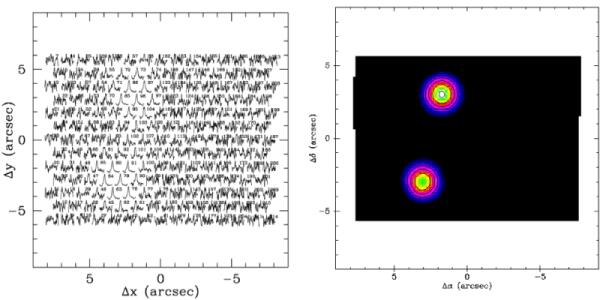 |
| Figure 3. Gravitational lens system Q0957+561 as observed with INTEGRAL. The picture on the left corresponds to the two-dimensional distribution of the 205 spectra obtained simultaneously with INTEGRAL in the 4500–4700Å wavelength range (the observed range is much larger). The continuum map (right) is done integrating the flux of the spectra in the 4500–4700Å wavelength range. The two point-like sources corresponding to the QSO compact images appear well resolved with a separation of 6.17 arcsec, in very good agreement with the distance inferred from the HST images (6.17 arcsec) (courtesy of Veronica Motta). [ JPEG | TIFF ] |
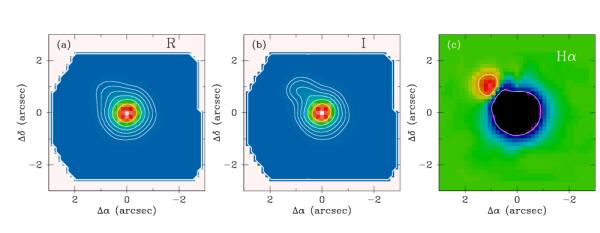 |
| Figure 4. Reconstructed
images from INTEGRAL spectra (in R, I, and H |
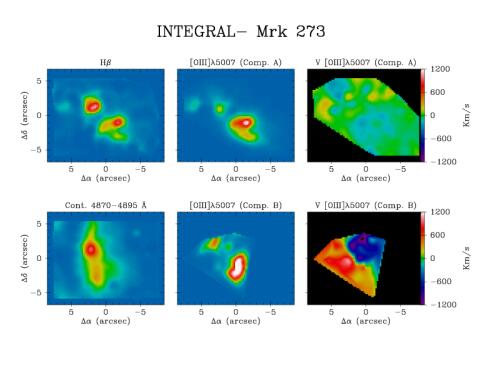 |
| Figure 5. Images
of several spectral features and ionised gas velocity fields generated
from the INTEGRAL spectra of the ultraluminous infrared galaxy Mrk 273.
Note the different morphology between the H |
 |
| Figure 6. The inner
region of the blue compact galaxy Mrk 370 shown by INTEGRAL. (a) Reconstructed
continuum in the spectral range of the V filter passband; (b) [OIII] |
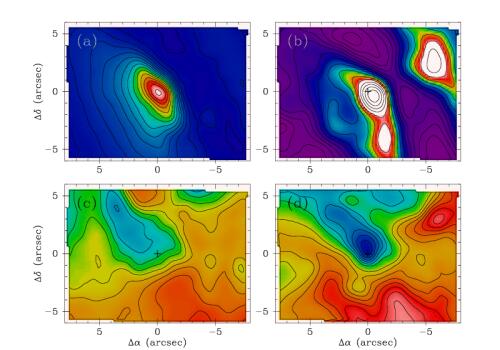 |
| Figure 7. INTEGRAL
observations of the Seyfert galaxy NGC2992. (a) Reconstructed continuum
map; (b) Integrated line intensity map of [OIII] |
References:
Email contact: Begoña García (bgarcia@ing.iac.es)
More information on INTEGRAL: http://andromeda.roque.ing.iac.es/~bgarcia/integral/html/integral_home.html
| Previous: | S-Cam Update - Novel Capabilities for Resolving Old Problems ! | Up: | Table of Contents | Next: | Fibre Feeding the UES |
| GENERAL | SCIENCE | TELESCOPES AND INSTRUMENTATION | OTHER NEWS FROM ING | TELESCOPE TIME |